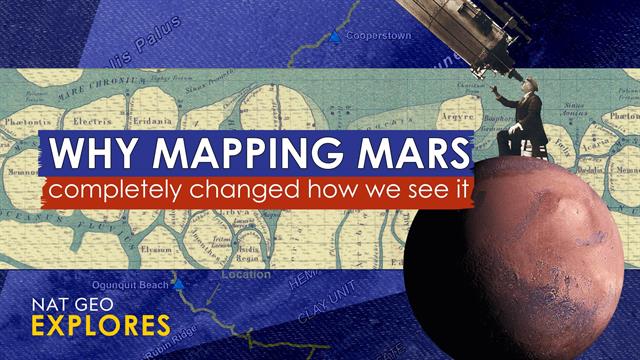From Competition To Captivation: The Story Of Mars's Charted Landscape

Welcome to your ultimate source for breaking news, trending updates, and in-depth stories from around the world. Whether it's politics, technology, entertainment, sports, or lifestyle, we bring you real-time updates that keep you informed and ahead of the curve.
Our team works tirelessly to ensure you never miss a moment. From the latest developments in global events to the most talked-about topics on social media, our news platform is designed to deliver accurate and timely information, all in one place.
Stay in the know and join thousands of readers who trust us for reliable, up-to-date content. Explore our expertly curated articles and dive deeper into the stories that matter to you. Visit NewsOneSMADCSTDO now and be part of the conversation. Don't miss out on the headlines that shape our world!
Table of Contents
From Competition to Captivation: The Story of Mars's Charted Landscape
For centuries, Mars has captivated human imagination, fueling science fiction and inspiring generations of scientists and explorers. But the red planet's allure extends beyond its fictional portrayals; the meticulous charting of its landscape represents a monumental achievement in human exploration, a story interwoven with scientific ambition, international competition, and groundbreaking technological advancements. This journey from competing national programs to a collaborative global effort has dramatically reshaped our understanding of Mars, and its potential for harboring past or even present life.
A Race to the Red Planet: The Early Years of Martian Cartography
The early days of Martian exploration were characterized by a fierce, albeit unspoken, competition between the United States and the Soviet Union during the Cold War. Both superpowers poured vast resources into their respective space programs, vying for dominance in the "Space Race." This competition spurred rapid advancements in rocketry, satellite technology, and remote sensing, which were crucial in the initial mapping efforts of Mars. Early maps, often rudimentary compared to today's high-resolution imagery, were primarily based on telescopic observations and limited data from early flyby missions. These early efforts, though imperfect, laid the foundation for future, more detailed cartographic studies.
The Mariner and Viking Missions: Revolutionizing Martian Mapping
The Mariner and Viking missions of the 1960s and 70s marked a significant turning point. These NASA missions provided the first close-up images of Mars' surface, revealing a landscape far more complex and intriguing than previously imagined. The Viking orbiters captured unprecedented detail, allowing scientists to create more accurate topographic maps, identifying major geological features like Olympus Mons – the largest volcano in the solar system – and Valles Marineris, a canyon system dwarfing the Grand Canyon. This influx of high-resolution data drastically improved our understanding of Mars' geological history and processes.
From Pixels to Precision: The Advancements of Modern Martian Cartography
The modern era of Martian mapping is defined by a shift from competition to collaboration. International partnerships and advancements in robotic exploration have revolutionized our ability to chart the Martian landscape. Missions like Mars Global Surveyor, Mars Odyssey, and the Mars Reconnaissance Orbiter have provided an unprecedented wealth of data, including high-resolution images, topographical data, and mineralogical information. This data is processed using sophisticated computer algorithms and software, creating incredibly detailed three-dimensional models of the Martian surface, revealing intricate details of its geological features, including ancient riverbeds, potential subsurface water ice, and evidence of past volcanic activity.
The Role of Rovers and Landers in Detailed Surface Mapping
Rovers like Curiosity and Perseverance have played a critical role in enhancing the precision of Martian maps. These robotic explorers provide ground-level data, offering close-up views of rock formations, soil composition, and atmospheric conditions. This detailed, in-situ data complements the orbital imagery, allowing scientists to create even more comprehensive and nuanced maps. The data collected by these rovers is continuously transmitted back to Earth, constantly refining our understanding of the planet's geology and potential habitability.
The Future of Martian Cartography: Towards a Complete Understanding
The quest to fully chart the Martian landscape is far from over. Future missions, including sample return missions and potential human exploration, promise to unlock even more secrets of the red planet. Advanced technologies, such as lidar and ground-penetrating radar, will provide even greater detail about the planet's subsurface features, helping to answer fundamental questions about the planet's history and the potential for past or present life. The ongoing collaboration between international space agencies signifies a shift towards a shared scientific endeavor, underscoring the immense value of global cooperation in exploring the mysteries of our solar system. The story of Mars's charted landscape is a testament to human ingenuity, perseverance, and the enduring fascination with the cosmos.

Thank you for visiting our website, your trusted source for the latest updates and in-depth coverage on From Competition To Captivation: The Story Of Mars's Charted Landscape. We're committed to keeping you informed with timely and accurate information to meet your curiosity and needs.
If you have any questions, suggestions, or feedback, we'd love to hear from you. Your insights are valuable to us and help us improve to serve you better. Feel free to reach out through our contact page.
Don't forget to bookmark our website and check back regularly for the latest headlines and trending topics. See you next time, and thank you for being part of our growing community!
Featured Posts
-
 Exclusive The Original Blueprint For Darby Allins Aew Reappearance
May 19, 2025
Exclusive The Original Blueprint For Darby Allins Aew Reappearance
May 19, 2025 -
 Ukraine Ceasefire Efforts Trump To Contact Putin And Zelenskyy On Monday
May 19, 2025
Ukraine Ceasefire Efforts Trump To Contact Putin And Zelenskyy On Monday
May 19, 2025 -
 Nuggets Playoff Hopes Hang In The Balance Game 7 Injury Report
May 19, 2025
Nuggets Playoff Hopes Hang In The Balance Game 7 Injury Report
May 19, 2025 -
 Knicks Playoff Run Continues Victory Over Celtics Sets Up East Finals Showdown
May 19, 2025
Knicks Playoff Run Continues Victory Over Celtics Sets Up East Finals Showdown
May 19, 2025 -
 Celtics Future Uncertain Weiss Explains How The Nbas Shift Impacts Boston
May 19, 2025
Celtics Future Uncertain Weiss Explains How The Nbas Shift Impacts Boston
May 19, 2025
